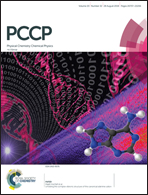Mechanistic role of nucleobases in self-cleavage catalysis of hairpin ribozyme at ambient versus high-pressure conditions†
Abstract
Ribozymes catalyze the site-specific self-cleavage of intramolecular phosphodiester bonds. Initially thought to act as metalloenzymes, they are now known to be functional even in the absence of divalent metal ions and specific nucleobases directly participate in the self-cleavage reaction. Here, we use extensive replica exchange molecular dynamics simulations to probe the precise mechanistic role of nucleobases by simulating precatalytic reactant and active precursor states of a hairpin ribozyme along its reaction path at ambient as well as high-pressure conditions. The results provide novel key insights into the self-cleavage of ribozymes. We find that deprotonation of the hydroxyl group is crucial and might be the penultimate step to the self-cleavage. The G8 nucleobase is found to stabilize the activated precursor into inline arrangement for facile nucleophilic attack of the scissile phosphate only after deprotonation of the hydroxyl group. The protonated A38 nucleobase, in contrast, mainly acts a proton donor to the O5′-oxygen leaving group that eventually leads to the self-cleavage. Indeed, systematic high-pressure simulations of catalytically relevant states confirm these findings and, moreover, provide support to the role of ribozymes as piezophilic biocatalysts with regard to their relevance in early life under extreme conditions in the realm of RNA world hypothesis.



 Please wait while we load your content...
Please wait while we load your content...